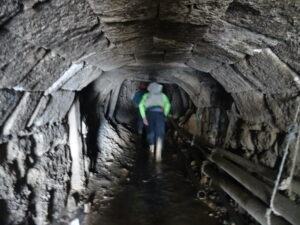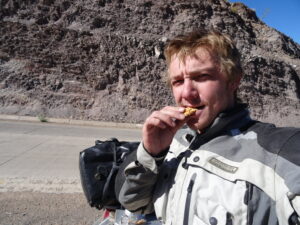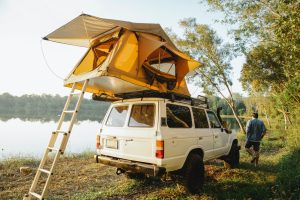
Road to Potosí
La Paz’s congestion is incessant. Even as I attempted to finally leave, it seemed like the city was trying to pull me back in like quick sand. A protest on the major highway bottle-necked one of the major routes out and it became a puzzle of cars, buses, and trucks. In a Pac-Man-like fashion, I snaked through traffic, sometimes traversing perpendicular across multiple lanes. This is certainly not a situation to hesitate in. See the space and move–like playing Tetris on Gameboy, except the consequences of a wrong move here could get you pinned or run over.
Having previously traveled the same road by overnight bus en route to the salt flats, I had an idea that the roads were going to be poor. Now visible in daylight, the human-sized pot holes mixed with falling snow combined for a few unpleasantries, to say the least.

The snow stopped but then came a line of stationary vehicles, mostly semis and buses, more than a mile long; their operators standing outside smoking and socializing–clearly not going anywhere soon. I had the wherewithal to cruise past hundreds of semi-trucks, cut to the front, and thankfully was waved through immediately. Construction had shut off a major section of highway and so they were sending us on a detour.
A mesmerizing mixture of snow dusted hills and a wind swept valley invited me to proceed. My smirk of enjoyment was harshly confronted with the reality of the horrendous condition of the detour. The fine, powdery sand of the road made handling difficult but that was not the worst part. Heavily trafficked by buses and trucks, swirling clouds of fine dust enveloped everything on the road. The next two hours became some of the dustiest of the my life – the talcum-like earth clinging to the back of my throat with every breath.

With the sun closing down for the night, I wearily approached the town of Oruro. In another frustrating search for a hotel, I failed to see a poorly marked speed bump and in the process, my left pannier was launched from the bike and it went sliding across the busy highway. Thankfully it hit nothing and I was able to run across the highway to grab my kit. After closer inspection, I could see that the attachment mechanism of my pannier was failing. Undoubtedly this would be an ongoing issue.
The warm, muggy days of Colombia felt so far away compared to the cold and wind-swept terrain I had become recently accustomed to. Another long day in the saddle and I was out like a light.

Potosí
The next day I set off for Potosí. The bureaucratic-run fuel stations provided me with more frustrations as I was refused service again because of my foreign license plates. Most of the time I felt that they were allowed to give me fuel but they just didn’t want to fill out the extra paperwork that was required for foreigners to buy fuel. Thankfully the ride was relatively short and arriving in the beautiful colonial city of Potosi in daylight was a welcomed change. Endless one-way streets sent me round and around and around in pursuit of my hostel.
At 13,420 feet, Potosi is one of the highest cities in the world and a UNESCO World Heritage Site. Its colonial architecture is pristine and the roads are maintained considerably better than the aggregate. Looming over the city is Cerro de Potosí; a silver mine that was founded in 1545. It provided the Spanish Empire with an unbelievable amount of silver and made Potosi one of the biggest cities in the New World. The mountain is still being mined to this day, although the production is minuscule in comparison to centuries ago.

Between the fame of the mountain and my grandfather being a gold miner in South Africa, I felt a strong draw to visit and so I signed up for a tour. Leaving the next morning, our group stopped at a roadside market for some snacks and gifts. As part of my offering, I purchased water, coca leaves, and dynamite; my logic being that when else would I be able to buy cocoa leaves and dynamite from a shop and gift them to someone?
Each member of the tour group received a helmet, headlamp, a high-visibility jumpsuit, and rubber boots. The importance of these items were not completely realized until we entered the absolutely atrocious conditions of the mine. Filthy water sat ankle deep; submerging most of the rail that carried the Indiana Jones-like mine carts.

Clearly lacking stringent regulation, the tunnels and shafts were irregular and narrow. The call for a fast moving mine cart came periodically and we were forced to push up against the walls to avoid being hit. This was a not a place to space off.
As we moved further into the mountain, the passages got so narrow at times that we had to crouch down to the size of a child to fit through. Random holes and shafts into the black abyss appeared at times and we had to navigate carefully around them. Through another hole we climbed and descended about 20 feet into the tunnel below. Our guide took us to a shrine to what was some interpretation of the devil. The miners gave offerings of coca leaves, cigarettes, and grain alcohol to the beady eyed, horned creature for safe passage underground.

After a moment with the shrine, we were lead along to an area that is privately mined by a single family. A father and son were working and they took the time to answer some questions through the help of the guide. In exchange, we gave them the dynamite and coca leaves; essential in the day to day grind of a Bolivian miner.
The tour continued through an incredible maze of tunnels and shafts. Towards the end, we encountered two brothers, both under age 15, who were working the mine. They explained that it was worth the risk and they made more money than if they worked in the fields. Nothing like meeting child laborers to make you appreciate your childhood even more.

Washing the Taste Out of My Mouth
The contrast from the dusty and dangerous silver mine to the beautifully white colonial buildings was stark. My time in Potosí was short but eye-opening and unforgettable. I considered heading to Sucre the next day but reports were coming back that the striking bus drivers had blocked the road to the city. Those trying to pass through were being pelted with rocks. Naturally, I decided that it was not worth it. With two relatively short days to the border of Argentina, my time in Bolivia was rapidly shrinking to a close.
Up next, frustrations follow me to the border and my departing impressions of Bolivia. Chapter 15: Bolivia is Type 2 fun
Start the journey from the beginning: Introduction









